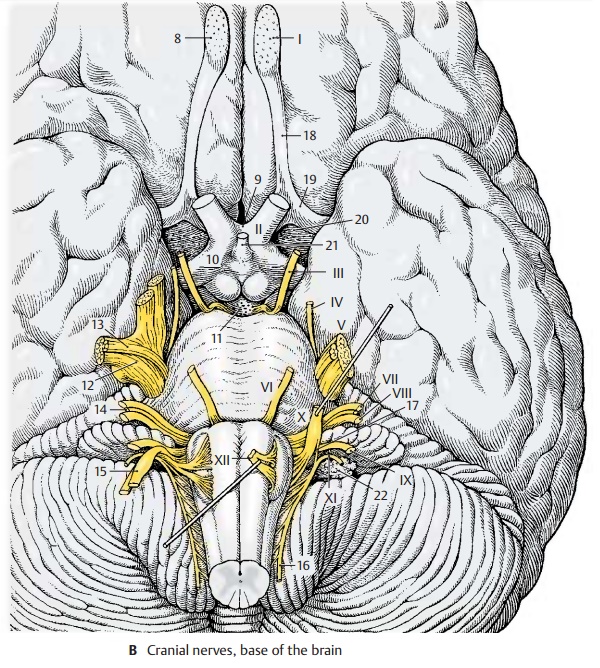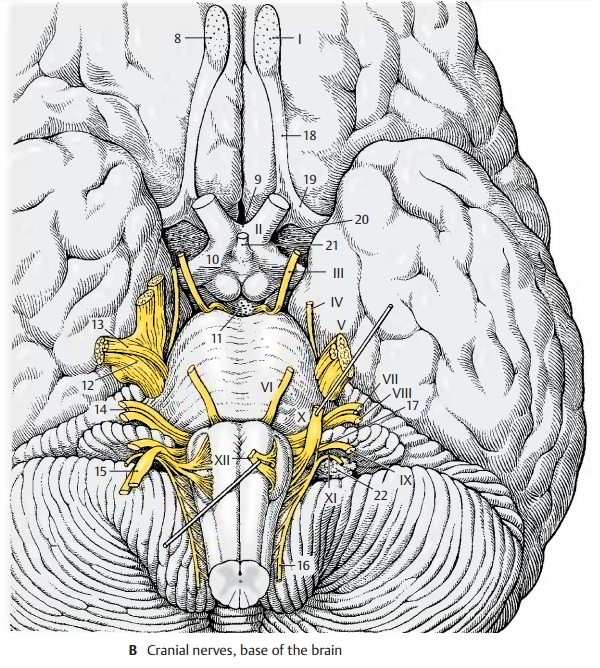Chapter: Human Nervous System and Sensory Organs : Brain Stem and Cranial Nerves
Cranial Nerves

Cranial Nerves
According to classical anatomical
nomen-clature, there are 12 pairs of
cranial nerves, although the first two pairs are not really peripheral
nerves. The olfactory nerve (I)
consists of the olfactory fibers, the bundledprocesses
of sensory cells in the olfactory
epithelium which enter the olfactory bulb(B8). The optical nerve
(II) is a cerebral pathway; the
origin of the opticalfibers, the retina, together with the pig-mented
epithelium of the eyeball repre-sents an evagination of the diencephalon. Optic chiasm (B9), optical tract (B10).
The eye-muscle nerves are
somato-motor nerves. The oculomotor
nerve (III) leaves the brain on the floor of the inter-peduncular fossa (B11);
thetrochlear nerve (IV) emerges at
the dorsal surface of the midbrain and extends around the cerebral peduncles to
the basal surface; the abducens nerve
(VI) emerges from the lower border of the pons.
Five
nerves have developed from the branchial
arch nerves of lower vertebrates:the trigeminal
nerve (V), the facialnerve (VII),
the glossopharyngeal nerve (IX), the vagus nerve
(X), and
the accessory nerve (XI). The muscles supplied by these nerves are
derived from the branchial arch muscles of the foregut. Hence, these nerves
have originally been visceromotor nerves. In mammals, the branchial arch
muscles have changed into the striated muscles of pharynx, oral cavity, and
face. Unlike genuine striated muscles, they are not completely voluntary (e.g.,
facial expression in response to emotion).
The vestibulocochlear nerve (VIII) with its vestibular part represents
a phylo-genetically old connection to
the organ ofbalance already present in lower vertebrates. The trigeminal
nerve (V) emerges from the lateral part of the pons. Its sensory root ex-tends to the trigeminal
ganglion (semilunarganglion, Gasser’s ganglion) (B12); its motor root (B13)
bypasses the ganglion. The facialnerve (VII) and the vestibulocochlear nerve
(VIII) leave the medulla oblongata at the cerebellopontine angle. The taste
fibers of the facial nerve emerge as an independent nerve, the intermediate nerve (B14). The glossopharyngeal nerve (IX) and the vagus nerve (X)
emerge dorsal to the olive. Supe-rior
ganglion of the vagus nerve (B15).
Thecervical roots of the accessory nerve (XI) unite to form the spinal root (B16). The upper fibers originating from the medulla oblongata form
the cranial root; they run a short
course in the nerve and change over to the vagus nerve as internal branch (B17).
The hypoglossal nerve (XII) is a somatomotor nerve; in ontogenetic terms,
it represents the remnants of several cervi-cal nerves that have become
included in the brain region secondarily and now have only rudimentary sensory
roots.
B18
Olfactory tract.
B19
Lateral olfactory stria.
B20
Anterior perforated substance.
B21
Hypophyseal stalk.
B22
Choroid plexus (flower spray of Bochdalek).

Related Topics